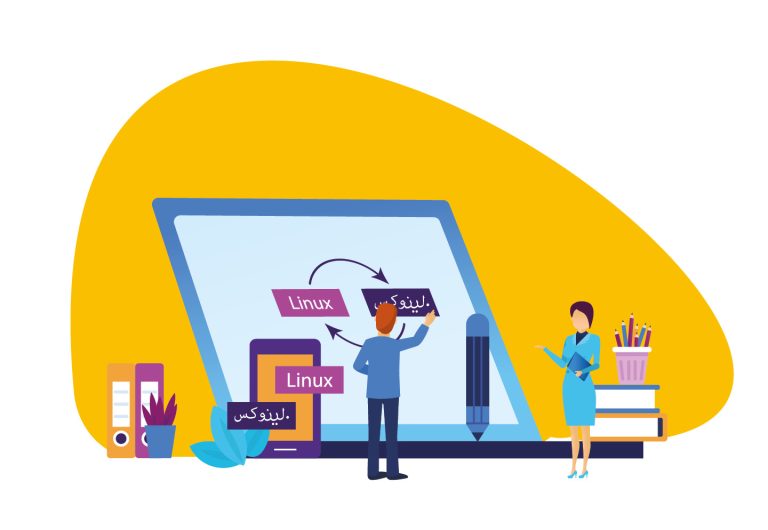Right-to-Left Scripts and other Translation Challenges

There are many learning materials about Linux and other free technologies on the Web, free of charge and accessible around the world. But one big barrier keeps many people from reading them: most are written in English, which billions of people do not know or aren’t comfortable with. Books and courses where you can learn English are not as easy as get as Linux, because most of these materials are not free or not available in many locations. Thus, the ocean of learning material for free software becomes useless for many.
The question regularly enters my mind: “Is it fair?”. For me, the answer is definitely, “No!”. So what can I do about it? Joining a translation movement is the answer I found.
Representing the needs of a relatively small group
In Farsi, the first language I speak, a lack of Linux resources is observable. Unlike for some languages such as German or Spanish, significant action has not been taken in Farsi to solve this problem. This information gap may be the most important reason that I contributed to the Linux Professional Institute (LPI) Learning Materials team and started to translate. People for whom whose Farsi is their native language (basically Iranians—Farsi is also sometimes called Persian) are in the minority. Therefore they have a small share of the publication market.
In recent years, more Farsi-speaking people have become familiar with Linux and use it more widely; however, the factors just mentioned result in a lack of attention to translation to Farsi. Additionally, sometimes Linux professionals who speak Farsi know English well—as I do—and aren’t motivated to translate materials to Farsi for their colleagues.
Despite all problems that I said, translation to Farsi has accelerated in recent years, and every day more people join the effort. This article summarizes the challenges and problems that I faced during translation. Generally, I categorize them into two categories; tools problems and translation dilemmas. However, these two issues are not isolated; they affect each other.
Tool challenges with right-to-left scripts
Farsi has some characteristics that distinguish it from commonly used languages. It is a right-to-left written language—undoubtedly the most significant difference between Farsi and other popular languages. Farsi shares this trait with a few other languages, notably Arabic.
So the most significant tool difficulty I found is that almost all software is designed based on left-to-right languages, and either have no concept of a right-to-left language or tack on support as an additional feature that isn’t well designed or integrated.
I was fortunate to find that OmegaT, the software that the Farsi team used for translation, supported Farsi, but there was a weird problem. Sometimes, when I tried to position the cursor on a line to edit or replace a word, I could not select the right one.
I am sure many readers are confused when I say this. Let me explain it by an example: Suppose you are editing the English sentence “I want to edit this wrng word.” You want to replace “wrng” with “wrong.” So you select “wrng” or put the cursor after it and use the Delete or Backspace key. Simple enough in a left-to-right language. But supposed that instead of deleting “wrng,” the editor deletes “want.” Sound weird? Believe me, it happened.
In short, the editor got confused about where the cursor was in a right-to-left language. It was so confusing and difficult to select a word that sometimes I would rewrite a whole line simply to edit a word. Other times, I copied the text to another editor, replaced the word I wanted to change, and copied it back to OmegaT. Recently I found a new workaround that is a little more efficient: I press “ctrl+Enter” in the middle of the line. The line splits into two or more parts. Then I can easily select the word and edit it, after which I can recombine the lines.
Translation dilemmas
Many of the issues I have to face, when choosing words and phrases, have been troubling translators forever. The first is the choice between fidelity and simplicity. Let me explain it with a question: should a translator translate the text word by word without any change in the structure, or am I allowed to modify the word order to make it simple for readers in the target language? This is not limited to English-to-Farsi translation; translators in other languages struggle with the same problem. There is no right answer. I generally try to make few changes, but in some situations, modification is inevitable.
Next, have you ever read an article in your native language that you could not understand? Now imagine being a non-native person who wants to translate it! The most complicated challenge for me was finding ambiguities in the original text. Sometimes, I would read a paragraph several times. Then I asked myself, “Is the text ambiguous, or do I just have trouble due to my limited knowledge of English?” In either case, understanding the meaning is impossible except by finding the writer and asking him or her. Luckily, I sometimes reached an understanding by doing web searches for phrases I could not understand. Seeing them in other texts, where I could get their meanings, helped me figure out their purpose and translate them. Another recourse I had was asking the LPI team for help. Getting every single phrase right because text is like a line of dominoes: misunderstanding one paragraph can lead to more errors in later paragraphs. It can results in a text that is severely different from the original text.
The next problem in this category involves cultural references. People sometimes mention something related to a country’s culture, religion, politics, sport, etc. For example, consider “he is better than the Oracle of Omaha”; you find the phrase meaningless if you do not possess the background culture that is behind this sentence. For these situations, the best way is to consult a search engine. But that’s just the first step in handling the text. To come up with an appropriate translation, you need to do more. You have to explain these references in your translation because, in the absence of an adequate explanation, readers from different cultures can not understand the references. In some cases, one phrase in the original text could translate into several sentences or require a footnote.
The last dilemma in this category is finding equivalent terms. A lot of English technical words enter Farsi directly, and no common translation exists. People use the original English words regularly Farsi speech and writing, and are not accustomed to hearing the Farsi equivalents. It would be awkward to translate a term such as “DevOps” into the precise Farsi words for “development” and “operations.” On the other hand, using a lot of English words like that leaves you with text that is basically English.
When people adopt a foreign word instead of looking for a translation, sometimes they transliterate the sounds into their native script; other times they stick in the original word. As an example of the first solution, we write “Linux” in Farsi as “لینوکس” “.لینوکس” is not a translation of Linux; it is just the same sounds rendered in the Farsi alphabet. The other solution, often used for abbreviations such as “TLS” or “PaaS,” is to keep them in the original English alphabet. This combination results in technical problems, especially in web pages. This is because, like software, web pages were designed basically for left-to-right languages. A single line mixing English words with Farsi words will mess up in a way that becomes unreadable. Also, some punctuation characters such as / (slash) or – (hyphen) make the text messy too. This is more than a translation challenge; we need more sophisticated layout software in web browsers to fix it.
Finding a balance between these choices is like walking on a tight-rope! Sometimes I read my translated text over and over, asking myself, “Could a normal reader understand it?” or “Is it really in Farsi?”. Nevertheless, my choices can never be perfect. Based on the users’ background about the technical text, their opinion could be different.
Despite all of these challenges, more and more people have joined the community translating technical documents to Farsi. The movement is not just limited to Linux, but takes place in other fields related to technology and science. We are still near the beginning of the process, and I am sure if it continues, Farsi will be given more attention. Maybe developers in the field of design are also thinking about the problems of right-to-left languages in software tool and web pages, and are fixing them. I am optimistic about the future.
